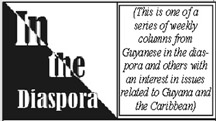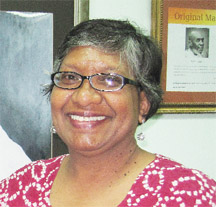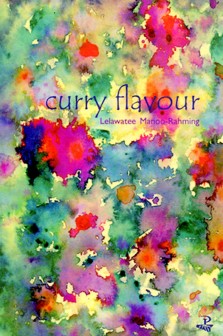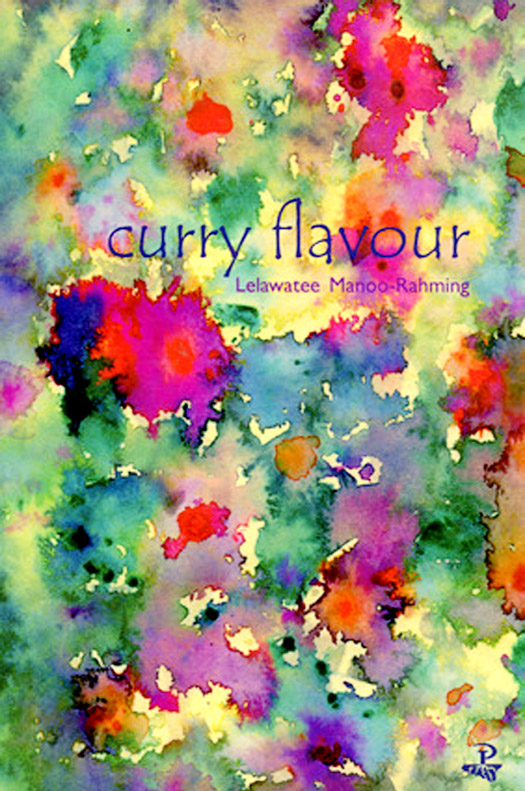Frank Birbalsingh is Professor Emeritus in the Department of English at York University in Toronto, where he taught for over thirty years. Among his many publications are The Rise of West Indian Cricket: From Colony to Nation (1996); Jahaji: An Anthology of Indo-Caribbean Literature (2000) and The People’s Progressive Party 1950-1992: An Oral History (2007).
By Frank Birbalsingh
With two volumes so far, Curry Flavour published in 2000, and Immortelle and Bhandaaraa Poems which appeared this year (2011), Lelawattee Manoo-Rahming introduces a fresh and original voice into Caribbean poetry, one steeped in her native, Indo-Trinidadian Hindu culture, and at the same time mixed, irreversibly creole. If this seems improbable, look at the opening poem in Curry Flavour “Incarnation on the Caroni” which consists of four stanzas, each ending with the line “on the banks of the Caroni.” Since the Caroni river gives its name to a region in central Trinidad historically associated with sugar cultivation and Indians, the insistent repetition of the name “Caroni,” four times, creates an urgent refrain linking the poem firmly to its local – Trinidadian and Caribbean – context.
 “Incarnation on the Caroni” opens with its persona’s claim that, unlike her Indian indentured ancestors, she never made the hazardous crossing of the kala pani (black water) from Calcutta, India, to Trinidad, although she has witnessed celebrations of Indian Arrival Day in Trinidad. In a direct address to her “nani” or maternal grandmother, the persona then asserts that upon death: “your soul is not charioted away/ by the great Vishnu [Hindu deity]/ it stays with me here/ on the banks of the Caroni River.” Even more strongly, the poem asserts that the grandmother’s lifeforce falls on sexually generative parts of the female persona’s body in a triumphantly erotic burst of images of rebirth and reincarnation. This link between the poet and her homeland seems indivisible. It is a creole link again asserted in “Footsteps in this Land” where the persona prays to an indigenous Caribbean deity: “Atabeyra/ Great Mother of the Caribbean sea/ Goddess of childbirth” for children to bring her:” a voice/ from my ancestral spirits/ in that faraway land [India]/ in the east.”
“Incarnation on the Caroni” opens with its persona’s claim that, unlike her Indian indentured ancestors, she never made the hazardous crossing of the kala pani (black water) from Calcutta, India, to Trinidad, although she has witnessed celebrations of Indian Arrival Day in Trinidad. In a direct address to her “nani” or maternal grandmother, the persona then asserts that upon death: “your soul is not charioted away/ by the great Vishnu [Hindu deity]/ it stays with me here/ on the banks of the Caroni River.” Even more strongly, the poem asserts that the grandmother’s lifeforce falls on sexually generative parts of the female persona’s body in a triumphantly erotic burst of images of rebirth and reincarnation. This link between the poet and her homeland seems indivisible. It is a creole link again asserted in “Footsteps in this Land” where the persona prays to an indigenous Caribbean deity: “Atabeyra/ Great Mother of the Caribbean sea/ Goddess of childbirth” for children to bring her:” a voice/ from my ancestral spirits/ in that faraway land [India]/ in the east.”
Other poems in Curry Flavour revel in sensuous evocations of Caribbean flora, fauna and culture, for example in “Waterfalls and Water Streams” which celebrates a landscape: “where the only falls are waterfalls/ and summer is perpetual.” As for the boisterous, fun-loving rituals of Caribbean festivals, nothing beats Christmas as in the poem “Down Home for Christmas” which extends the wish to: “Have a rake n’ scrape/Slammin’ jammin’/ Down Home Christmas.” Yet in “Carifesta Five – Rebirth” we are reminded of the genocide at the very foundation of Caribbean history with the: “lifeblood of Caribs and Arawaks/ Africans and Indians/ buried forever in the/ Caribbean sea.” Seldom do we find as succinct and sober an assessment both of the tragic origins of modern Caribbean history, and of the cheering resilience of West Indians in coping with it.

The historical effort to restore divisions caused by colonial conquest appears in the following stanza of “Carifesta Five – Rebirth” which celebrates West Indian history, heroes, musicians and local deities: “over here I see Dessalines/ over there Jose Marti/ and while Garifuna and Kuna/ chant life poetry/ with Invader and Destroyer/ Lokono and Shango/ dance the monkey dance/ till I dream that even/ Hanuman has been reborn/ in this Carifesta Five/ of my Caribbean Sea.” Carifesta or the Caribbean Festival of Arts is a multicultural event held periodically to celebrate Caribbean art and culture; Jean-Jacques Dessalines was the first leader of an independent Haiti in 1801; Jose Marti is Cuba’s supreme patriot and revolutionary poet; Garifuna are shipwrecked African slaves who inter-married with Carib islanders and adopted the Carib language while retaining some of their own customs before they moved to Belize; the Kuna are indigenous people of Panama and Colombia; and Hanuman is the Hindu monkey god. That these divisions of territory, race, religion, colour, ethnicity and language can merge so effortlessly in her poem is certainly due to Manoo-Rahming’s technical skill but also, crucially, to her wonderfully integrated creole voice and vision.
Born in 1960 as one of seven children in a poor Indian family in rural Trinidad, Manoo-Rahming won a scholarship to St. Augustine’s Girls High School from where she proceeded to study engineering at the University of the West Indies in St. Augustine. There she met a fellow student – Hammond Rahming – a white Bahamian, whom she married and with whom she later settled in the Bahamas. In addition to practising professionally as a Mechanical/Building Services Engineer in Nassau, Bahamas, Manoo-Rahming writes poems, stories and essays as well as producing sculpture, drawing and painting. For a woman to thrive in the generally male world of professional engineering is one thing; for her to do so while pursuing multiple artistic endeavours is surely proof of tremendous energy, not to mention broad sympathies, a mixed, cosmopolitan outlook and rare technical versatility! In an interview Manoo-Rahming admits it was not until she went to the Bahamas where a paucity of Indians made her noticeable as an “outsider,” that she was inspired to explore her inherited Hindu belief, and formally research her Indo-Caribbean cultural roots which she had taken for granted in Trinidad. Her art evolves out of this exploration and research.
Inevitably, the self-exploration already seen in Curry Flavour continues in Immortelle and Bandaaraa Poems which is divided into five sections that pay tribute to various deities, for instance, the Hindu goddesses Bhavani, Durga and Shakti respectively in Sections One, Two and Five of the volume, the indigenous tempest-raising Caribbean goddess Coatrische in Section Three, and the classical Greek goddess Hecate in section Four. This devotion to female goddesses evidently betrays strong feminist leanings which are no less genuine for being seen in cooperation with devotion to male deities; for Manoo- Rahming often adopts a devotional structure in poems where male and female personae are portrayed as weak and fallible, constantly in need of divine wisdom, guidance and support. So far as the title of the second volume is concerned, “Bhandaaraa” is a Hindu ceremony held twelve or thirteen days after a death in order to assist the release of the dead person’s soul from their body: it explains the volume’s preoccupation with spiritual matters of devotion and transcendence. But far from being philosophical and esoteric as it may sound, the subject remains concretely linked to Trinidad by the immortelle which was planted as a shade tree on Trinidad cocoa plantations during colonial times.
 Although not formally devotional in structure, some poems in Immortelle, for instance, “Ocean Goddess on a Journey” adopt a pose of gratitude for divine blessings, in this case, for the blessing of human connection or friendship in spite of wide differences or divisions, not only in the Caribbean but in the world as a whole. The West Indian persona in the poem meets a poet from the Pacific islands who is also visiting San Francisco in California. The persona exults in similarities between her and her fellow visitor, namely, her shared response to the tropical richness of Pacific fruit and flowers for which homage is paid to the Polynesian goddess “Great Hina, Creator, Death Mother.” But it is the blessing of their connection or friendship for which the persona is most grateful. She delights in her connection to her fellow visitor: “I wanted to tell you that I too/ Come from an island home –in the Caribbean/ Where we worship our own Indian and African/Ocean Goddesses – Lakshmi and Yemaya/ Offering them hibiscus, coconut, banana/ Rejuvenating ourselves in sea baths.”/ Lakshmi is the Hindu goddess of wealth, prosperity and much else, while Yemaya is a Yoruba African deity adopted as a Caribbean Ocean goddess. Like so many other poems in the volume the chief appeal of “Ocean Goddess on a Journey” is the warmth of its transcendent sense of human brotherhood, and the comforting humility of its prayerful, worshipful acceptance as a blessing from higher (divine) authority.
Although not formally devotional in structure, some poems in Immortelle, for instance, “Ocean Goddess on a Journey” adopt a pose of gratitude for divine blessings, in this case, for the blessing of human connection or friendship in spite of wide differences or divisions, not only in the Caribbean but in the world as a whole. The West Indian persona in the poem meets a poet from the Pacific islands who is also visiting San Francisco in California. The persona exults in similarities between her and her fellow visitor, namely, her shared response to the tropical richness of Pacific fruit and flowers for which homage is paid to the Polynesian goddess “Great Hina, Creator, Death Mother.” But it is the blessing of their connection or friendship for which the persona is most grateful. She delights in her connection to her fellow visitor: “I wanted to tell you that I too/ Come from an island home –in the Caribbean/ Where we worship our own Indian and African/Ocean Goddesses – Lakshmi and Yemaya/ Offering them hibiscus, coconut, banana/ Rejuvenating ourselves in sea baths.”/ Lakshmi is the Hindu goddess of wealth, prosperity and much else, while Yemaya is a Yoruba African deity adopted as a Caribbean Ocean goddess. Like so many other poems in the volume the chief appeal of “Ocean Goddess on a Journey” is the warmth of its transcendent sense of human brotherhood, and the comforting humility of its prayerful, worshipful acceptance as a blessing from higher (divine) authority.
But Manoo-Rahming’s devotional stance should not be taken as a sign of weak-kneed submission or negation. In “No-People Land” where a typical Third World country is on the edge of poverty and collapse, and where the inhabitants are best described as “No-People,” the land is described as follows: “While Our Father in heaven reigning/ Children ah de earth have hungry bellies/ Full up big with gas and malnu paining./” Things are so bad that the poem goes on to call the land: “behind-God-back place…/ Just a bubbly, muddy Devil’s Woodyard/ Full with rotten-egg fumes ah pig-pen stink.”/ Yet there is an instinct to survive expressed in the following lines: “Buh look good, good, see how amoebae thrive/ See zygote cells multiply in a blink/ Hatching de guppy roe dat survive/ Little mermaid goddesses transparent/ For dem who can read de message within/ Who can start a new talk to make things right/ Bellies full with food and faces grinning./” What is also notable is the creole idiom of the poem which, perhaps more than anything else, proclaims the authentic creole quality of the poet’s voice.
The versatility of Manoo-Rahming’s art is evident in her inclusion of reprints of ten of her paintings in the first few pages of Immortelle, each reprint identified with one particular poem in the same volume. For example, the painting “Immortelle,” shows a lush Trinidadian landscape with a richly coloured immortelle tree in the foreground. The painting is identified with a poem also named “Immortelle” which is dedicated to the memory of Lord Shorty, the calypso singer who joined Indian music and musical instruments with African rhythms to create a new musical genre called ‘socah.’ The combination of an emblematic Trinidadian tree with a uniquely Trinidadian musical form could not be more symbolic of the wholeness of Trinidadian culture or nationality.
Another aspect of versatility in Immortelle is the poet’s inclusion of more than forty pages of Glossary and Notes that account for about one quarter of the length of the volume. This is hugely impressive because it contains results of extensive research both into Hindu theology and Caribbean history, politics, culture and folklore. While it takes nothing away from the sensuous pleasure of sexual relationships evoked , for example, in “Incarnation on the Caroni” and “My Coontie,” or the sheer colour and delight in Caribbean scenery displayed both in her poems and paintings, Manoo-Rahming’s inclusion of “Glossary and Notes” in her second volume of poems corroborates a seriousness and dedication to her craft that is only found in the most distinguished Anglophone Caribbean poets – women like Lorna Goodison and Olive Senior, and men like Derek Walcott and Kamau Brathwaite.
Manoo-Rahming’s poetry deserves a wide audience across the Caribbean and beyond. If her work is not already available, Guyanese bookstores should order it – you will not be disappointed.

